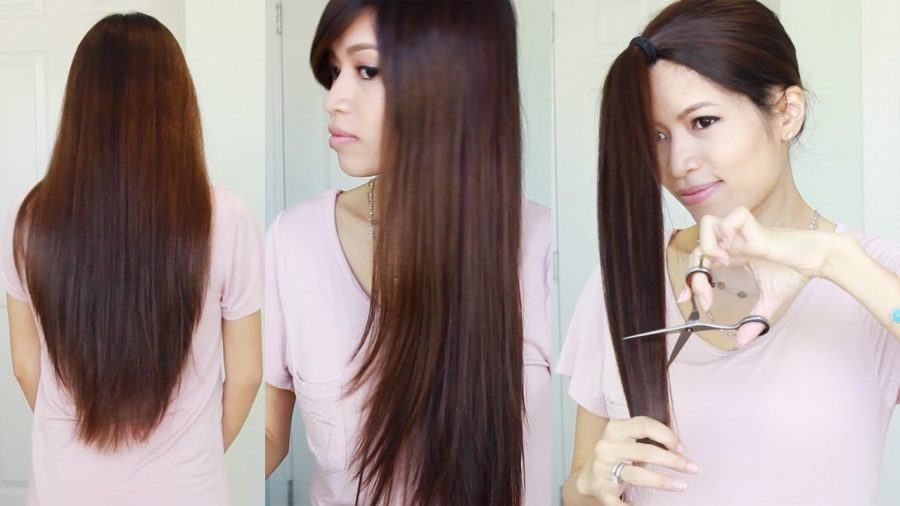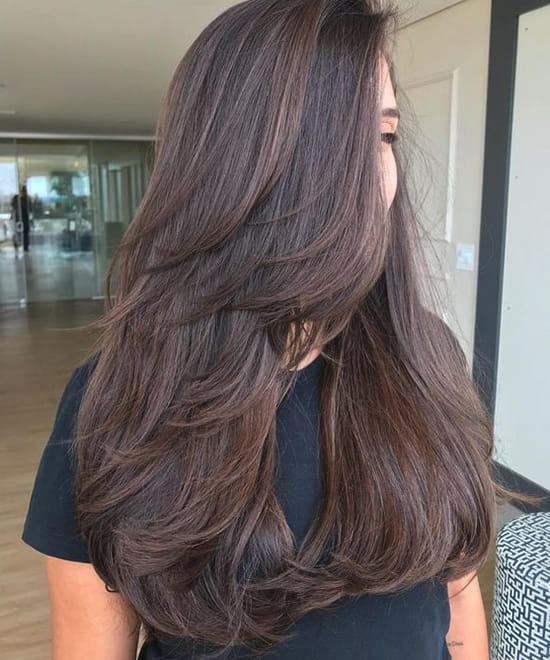On numerous occasions, we’ve been cautioned not to cut our own hair at home. Hair beauticians all over, myself notwithstanding, remind their clients and supporters that such an unsafe move that could blow up and leave you needing more assistance than you were initially later.
In any case, talking as a beautician, I can certainly say that cutting your own face-outlining layers is not difficult to-accomplish and can give your haircut a tremendous lift (and some major reshaping). While I can propose cutting your own face-outlining layers on medium to longer lengths, I’ve laid out all that you want to know about doing this DIY move cautiously and certainly, very much like a professional. Continue to peruse for our 10-venture guide on the most proficient method to cut the ideal face-outlining layers at home.

How to cut your own hair long layers
Materials:
- Shears (should be hair-cutting shears, not normal scissors)
- Cutting brush (with fine and wide teeth)
- Cutting cape
- Reflect, ideally in a sufficiently bright region
- Cuts for separating
- Blow dryer
How to cut your own hair long layers
- Prep Your Hair
I have confidence in a dry cut, regardless kind of surface you have. The way to doing this appropriately is ensuring the hair and scalp are spotless. This will guarantee there is no item develop or sebum (normally delivered oil) overloading the hair at the roots, which would make the hair lay diversely after it’s washed. So ensure your hair has been as of late washed and is liberated from all items. Presently how about we center around your surface.
You will do one of two things: leave your regular surface in respect and let it air dry 80% of the way, or smooth out your surface assuming that is the manner by which you typically wear it consistently. The mark of this is to cut your hair the manner in which its well used so you can see how and where the hair needs to fall. Try not to twist, fix, or utilize any hot instruments to style your hair presently. We just need to pick either regular development or a streamlined blow dry.
In the event that you’re asking why we aren’t cutting the hair while it’s wet, this is on the grounds that our hair will normally contract up whenever it’s dried. For a DIY home cut, we don’t need any amazements. By cutting your hair while its dry, we’ll have the option to cut the hair in light of its prompts, not against them. It will likewise give you a superior visual of any shriveled, split closures that need to go. Basically: leave the wet cuts for the professionals.
- Segment Your Cutting Area
ASHLEY RUBELL
Track down your regular or favored splitting. In the event that you like to throw your hair around a great deal or change around your splitting much of the time, choose a middle splitting. Whenever you’ve recognized and tidied up your splitting, utilize the edge of your cutting brush to segment your hair from about a large portion of an inch behind the ears. Going marginally past the ear line should give you a little piece from the back length so that you’re cutting to meet the longest place of the hair. Brush the hair forward and utilize your clasps to partition the remainder of the hair.
- Settle On Your Starting Point
Where do you need your layers to begin? Face outlining layers are tied in with opening things up and featuring one’s facial highlights. Remember this while picking your beginning stage. With the majority of your hair previously cut back, pause for a minute to see your face shape and the elements you need to feature. I would agree that my face shape is square, and for best outcomes I normally like front layers to highlight my cheekbones. In light of this, I will begin my layers somewhere close to my cheekbones and my jawline. You’ll likewise need to think about your length. Assuming that you have extra lengthy hair, beginning just beneath the jaw is continuously going to be your most secure wagered. Regardless of your length or face shape, you never need to begin your face outlining layers over the cheekbones or nose level.
The briefest highlight start your face outlining layers is at similar level as your nose or cheekbones.
- Make Your Guide
It’s at long last an ideal opportunity to begin clipping ceaselessly. To start, utilize the fine tooth end of your cutting brush to present a little quarter inch segment of hair from each side of your normal splitting. Cautiously bring that down to your beginning stage, haul it out somewhat so you can see how you’re accomplishing more exactness, and start to delicately coast your shears down the hair. You won’t be shutting your shears, or hauling them, however slide cutting your direction down the hair. Continue to peruse for more exhaustive directions on the most proficient method to appropriately slide cut.
- Slide Cutting
For this specific cut, I propose a strategy called slide cutting. Slide cutting is an extremely delicate methodology that empowers adaptability and less leeway. Try to move slowly. By keeping your shears open and making sensitive heartbeats never completely shutting your shears together – let your shears skim their direction down the front of the hair. Recollect you are not cutting into the hair by any means. Everything really revolves around going straight down from your aide.
Slide cutting will give you a flawed but in a good way degree to fill in as a base for your face outlining layers. Utilize your cutting brush to coordinate all the hair forward, over your face and squeeze out each minuscule subsection in turn, every one underneath the other. Taking little subsections and a delicate methodology with this cutting strategy will give you the most command over how you’re treating a fledgling.
To coast your shears down securely, you need to unobtrusively beat your two fingers as they advance down. You can constantly work on doing this prior to taking the shears to your hair. Without these delicate heartbeats, you could tragically drag the shears down as opposed to floating them and that would cause more fraying at the finishes, resulting in the hair inclined to harm and frizz.
When you have your aide cut in the middle, return to your normal splitting and let that beginning stage guide you down to other little subsections on each side. While cutting one side will constantly feel more normal, slide cutting keeps that opposite side from feeling incredibly unfamiliar and more inclined to significant missteps.
- Point Cutting
Since you’ve made a free face outlining shape, we will utilize guide cutting toward adjust our layers. Starting at your most limited length, gradually lift the hair up in little areas and make delicate cuts straightforwardly into the hair. This will mellow our lines and allow us one more opportunity to take out any frayed looking closures. It will likewise assist us with easing up things up any place the hair has all the earmarks of being a piece cumbersome. By point cutting straightforwardly into a solitary spot, we can accomplish a little division in our layers.
Utilize your brush to coordinate the hair across your face at a low 45 degree point. This will show you the line you’ve made toward the front. Assuming there are any longer pieces on the top, or lopsided regions that stick out from a clean-ish line, you’ll need to direct cut into those spaces toward even things out, as displayed previously. Keep on taking little segments right down to your longest length. Whenever you’ve completed on each side, you should start to see your outcomes coming to fruition.
- Cross Check
Brush the hair down around your face. Verify that there aren’t any significant contrasts between each side. Keep in mind, we’re going for a flawed but in a good way look, yet there should in any case be some conspicuous balance. You could observe one side feels really testing, so take as much time as is needed. This is a second to return in and slide cut or point cut any lopsided pieces. Use slide cutting to change your length and guide cutting toward change your general shape.
- Mixing the Back Section
After you realize the front is doing great, it’s an ideal opportunity to present the back and perceive how everything mixes together. Eliminate your clasps and utilize your brush to divide the hair into equal parts, presenting each side. By utilizing guide cutting toward mix our lengths together, we’ll have the option to mellow any “rack” looking regions in wavy or wavy hair, and any separated regions for streamlined strands. Mixing your front layers into your general length is significant to stay away from any disengagement between your longest front layer and the closures of your general hair length. On the off chance that they don’t naturally work well together, you might have a few corners to wipe out or mellow. By and by, I really hate a U-formed haircut, so to stay away from this, I previously utilized guide cutting toward trim my closures on the two sides straightforwardly across. Then, at that point, I mixed my recently managed closes into my new face outlining layers however utilizing guide cutting toward relax the point between those two lengths. In any case, everything revolves around private inclination.

- Style As Usual
This is the last step of How to cut your own hair long layers when I completed the process of cutting, I styled my hair as expected with a blow dryer and hair curler. I went straight for my go-to items: a blow dry introduction for normal lift, heat security, and smoothing and a dry surface splash for completing to feature the development I made in my front layers. Despite the fact that I just layered the front pieces and managed the finishes, I felt like my whole haircut got a truly necessary makeover.
Assuming you’re actually having an uncertain outlook on doing this all alone, don’t spare a moment to connect with me or whoever your go-to beautician is for a web-based conference to walk you through the movements recorded previously!
